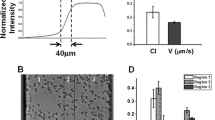Abstract
Several studies which have been performed some years ago showed that increased cAMP levels are associated with inhibition of directional locomotion1,2,3,4,5. The increased cAMP levels were detected 2 minutes after chemotactic stimulation or later. Extracellular dibutyryl cAMP inhibited the cytotaxin-induced directional locomotion2,6,7,8. The results led to the conclusion that, though cAMP is not in the main sequence of events triggering the chemotactic response, increases in cAMP may modulate directional locomotion.
Access this chapter
Tax calculation will be finalised at checkout
Purchases are for personal use only
Preview
Unable to display preview. Download preview PDF.
Similar content being viewed by others
References
Hatch, G. E., Nichols, W. K., and Hill, H. R., Cyclic nucleotide changes in human neutrophils induced by chemoattractants and chemotactic modulators, J. Immunol., 119: 450 (1977).
Rivkin, I., Rosenblatt, J., and Becker, E. L., The role of cyclic AMP in the chemotactic responsiveness and spontaneous motility of rabbit peritoneal neutrophils. The inhibition of neutrophil movement and the elevation of cyclic AMP levels by catecholamines, prostaglandins, theophylline and cholera toxin, J. Immunol. 115: 1126 (1975).
Till, G., Kownatzki, E., Seitz, M., and Gemsa, D., Chemokinetic and chemotactic activity of various prostaglandins for neutrophil granulocytes, Clin. Immunol. Immunopathol., 12: 111 (1979).
Gallin, J. I., Sandler, J. A., Clyman, R. I., Manganiello, V. C., and Vaughan, M., Agents that increase cyclic AMP inhibit accumulation of cGMP and depress human monocyte locomotion, J. Immunol. 120: 492 (1978).
Hill, H. R., Cyclic nucleotides as modulators of leukocyte chemotaxis, in: Leukocyte Chemotaxis, J. I. Gallin and P. G. Quie, eds., Raven Press, New York, p. 179 (1978).
Tse, R. L., Phelps, P., and Urban, D., Polymorphonuclear leukocyte motility in vitro. VI. Effect of purine and pyrimidine analogues: possible role of cyclic AMP, J. Lab. Clin. Med., 80: 264 (1972).
Giroud, J. P., and Roch Arveiller, M., In vitro effect of cyclic nucleotides on velocity and chemotaxis of neutrophil granulocytes, Biomedicine, 27: 246 (1977).
Estensen, R. D., Hill, H. R., Ouie, P. G., Hogan, N., and Goldberg, N. D., Cyclic GMP and cell movement, Nature, 245: 458 (1973).
Keller, H. U., Gerisch, G., and Wissler, J. H., A transient rise in cyclic AMP levels following chemotactic stimulation of neutrophil granulocytes, Cell. Biol. Int. Reports, 3: 759 (1979).
Jackowski, S., and Sha’afi, R. I., Response of adenosine cyclic 3’5’-monophosphate level in rabbit neutrophils to the chemotactic peptide formyl-methionyl-leucyl-phenylalanine Mol. Pharmacol., 16: 473 (1979).
Simchowitz, L., Fischbein, L. C., Spilberg, I., and Atkinson, J. P., Induction of a transient elevation in intracellular levels of adenosine-3’5’-cyclic monophosphate by chemotactic factors; an early event in human neutrophil activation, J. Immunol., 124: 1482 (1980).
Smolen, J. E., Korchak, H. M., and Weissmann, G., Increased levels of cyclic adenosine-3’5’-monophosphate in human polymorphonuclear leukocytes after surface stimulation, J. Clin. Invest., 65: 1077 (1980).
Marx, R., Bass, D., and McCall, C., Correlation of stimulation or suppression of chemokinesis and chemotaxis of human neutrophils (PMNL) with early changes in cyclic AMP, Fed. Proc., 38: 4970 (1979).
B$yum, A., Separation of leucocytes from blood and bone marrow, Scand. J. clin. Lab. Invest., 21: 1 (1968).
Keller, H. U., Gerber, H., Hess, M. W., and Cottier, H., Studies on the regulation of the neutrophil chemotactic response using a rapid and reliable method for measuring random migration and chemotaxis of neutrophil granulocytes, Agents and Actions, 6: 326 (1976).
Gerisch, G., Maeda, Y., Malchow, D., Roos, W., Wick, U., and Wurster, B., Cyclic AMP signals and the control of cell aggregation in Dictyostelium discoideum, in: Developments and Differentiation in the Cellular Slime Moulds, Cappuccinelli and Ashworth, eds., Elsevier/North-Holland Biomedical Press, p. 105 (1977).
Gerisch, G., Fromm, H., Huesgen, A., and Wick, U., Control of cell-contact sites by cyclic AMP pulses in differentiating Dictyostelium cells, Nature, 255: 547 (1975).
Spilberg, I., Mandell, B., Mehta, J., Sullivan, T., and Simchowitz, L., Dissociation of the neutrophil functions of exocytosis and chemotaxis, J. Lab. Clin. Med.; 92: 297 (1978).
Spilberg, I., Mandell, B., and Hoffstein, S., A proposed model for chemotactic deactivation. Evidence for microtubule modulation of polymorphonuclear leukocyte chemotaxis, J. Lab. Clin. Med., 94: 361 (1979).
Weissmann, G., Smolen, J. E., and Korchak, H. M., Release of inflammatory mediators from stimulated neutrophils, New Engl. J. Med., 303: 27 (1980).
Snyderman, R., and Pike, M. C., N-formylmethionyl peptide receptors on equine leukocytes initiate secretion but not chemotaxis, Science, 209: 493 (1980).
Ward, P. A., and Becker, E. L., The deactivation of rabbit neutrophils by chemotactic factor and the nature of the activatable esterase, J. Exp. Med., 127: 693 (1968).
Author information
Authors and Affiliations
Editor information
Editors and Affiliations
Rights and permissions
Copyright information
© 1982 Plenum Press, New York
About this chapter
Cite this chapter
Naef, A., Keller, H.U. (1982). A Short Transient Increase in Cyclic Adenosine 3′, 5′-Monophosphate Levels of Neutrophil Granulocytes Following Exposure to Chemotactic Factors. In: Rossi, F., Patriarca, P. (eds) Biochemistry and Function of Phagocytes. Advances in Experimental Medicine and Biology, vol 141. Springer, Boston, MA. https://doi.org/10.1007/978-1-4684-8088-7_5
Download citation
DOI: https://doi.org/10.1007/978-1-4684-8088-7_5
Publisher Name: Springer, Boston, MA
Print ISBN: 978-1-4684-8090-0
Online ISBN: 978-1-4684-8088-7
eBook Packages: Springer Book Archive




